On rainy days, your solar panels still produce electricity, though at reduced levels, thanks to diffuse sunlight reaching the panels. Rainwater helps keep the panels clean and free of dirt, which can boost efficiency over time. Modern panels are built tough to withstand weather conditions. So, even in gloomy weather, your system continues to work reliably. Want to discover more about how weather affects your solar investment and tips to optimize it? Keep exploring!
Key Takeaways
- Solar panels still generate electricity during rainy days by capturing diffuse and indirect sunlight, though at reduced efficiency.
- Rain naturally cleans panels, improving long-term performance and reducing maintenance needs without manual cleaning.
- Modern weatherproof panels are durable, resistant to water, snow, and wind, ensuring reliable operation in adverse weather conditions.
- Cloud cover and rain lower overall energy output but can still contribute meaningfully to your power supply.
- Proper system design, placement, and technology maximize solar energy capture even during overcast and rainy weather.
How Rain and Clouds Affect Solar Panel Performance
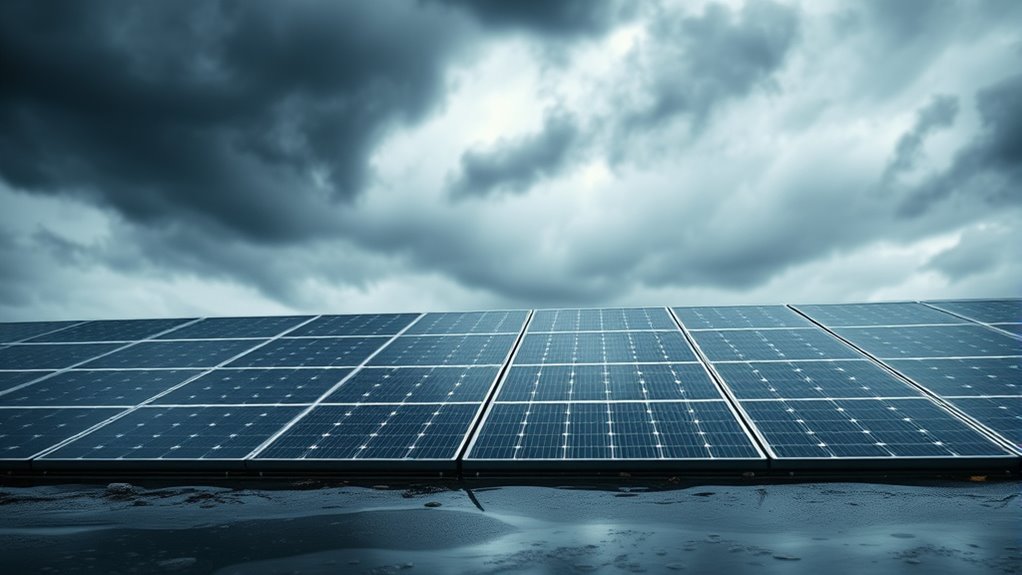
Rain and clouds can substantially reduce the efficiency of your solar panels, even though they don’t completely stop energy production. When the sky is overcast, less sunlight reaches your panels, decreasing their power output. However, modern solar panel durability and weatherproof technology help them withstand harsh conditions, including rain and cloud cover. These features prevent water damage and corrosion, ensuring your system remains functional over time. While performance dips during gloomy days, your panels are designed to operate reliably despite the weather. Properly installed, weatherproof technology guarantees your investment continues to work efficiently, rain or shine. Additionally, solar panel technology has advanced to optimize energy capture even during less-than-ideal weather conditions, maximizing your system’s potential.
The Science Behind Solar Energy Generation in Overcast Conditions
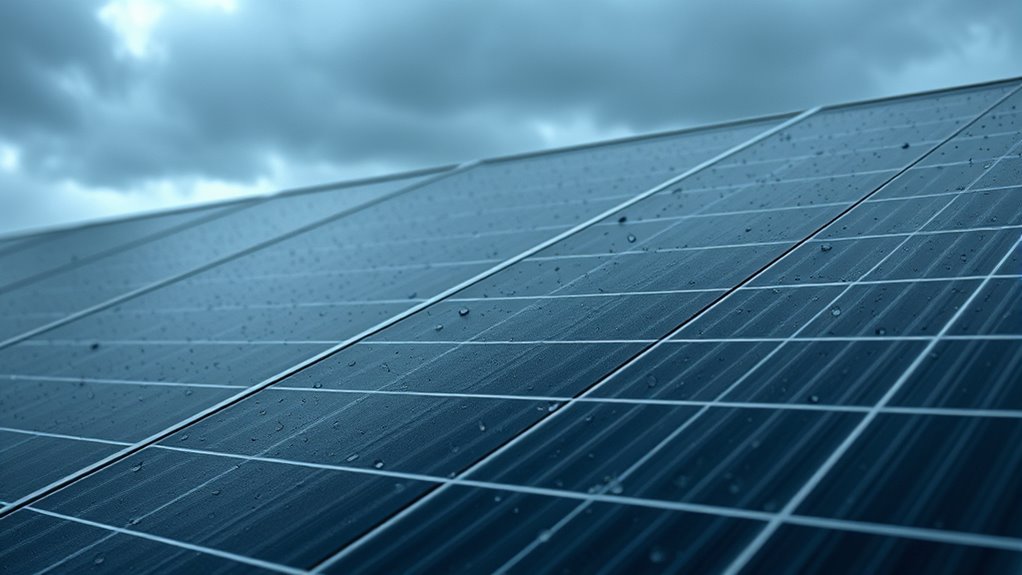
On overcast days, your solar panels still capture some sunlight, but their efficiency drops. This happens because cloud cover reduces light absorption, limiting how much energy your panels can generate. Understanding how light absorption and cloud cover interact helps you grasp how solar energy works even when the sky is cloudy. Additionally, the solar energy generation process can be affected by regional factors and the quality of your panels.
Light Absorption Efficiency
Even when the sky is cloudy, solar panels can still generate electricity because they are designed to absorb a broad spectrum of light, including diffuse and indirect sunlight. Their light absorption efficiency depends on factors like solar panel coloring and the sunlight spectrum they can utilize. Darker-colored panels tend to absorb more light, increasing efficiency in overcast conditions. Different panels are optimized to capture various wavelengths, making them adaptable to cloudy days. This flexibility allows your system to produce power even with limited direct sunlight. Understanding how these factors affect absorption helps you maximize solar energy, regardless of weather. Here’s a quick look at how light absorption varies:
| Panel Color | Sunlight Spectrum | Absorption Efficiency |
|---|---|---|
| Black | Full spectrum | High |
| Blue | Visible light | Moderate |
| Silver | Diffuse light | Good |
| White | Less effective | Low |
| Green | Partial spectrum | Variable |
Cloud Cover Impact
Cloud cover considerably influences how well your solar panels produce electricity, as it scatters and diffuses sunlight before it reaches the surface. When the sky is overcast, thick clouds create significant shading, reducing the intensity of direct sunlight. This cloud cover decreases the amount of usable solar energy hitting your panels, leading to lower power output. Solar panel shading caused by clouds isn’t uniform; some areas may receive more diffuse light than others, which can affect overall efficiency. While panels still generate electricity under overcast conditions, their performance drops compared to sunny days. It’s important to understand that overcast skies don’t completely stop energy production—they just limit it. Being aware of how cloud cover impacts your system helps you set realistic expectations and optimize your solar setup. Additionally, diffuse sunlight can still contribute to energy generation, albeit at a reduced rate.
Do Rainy Days Reduce Your Solar System’s Efficiency?
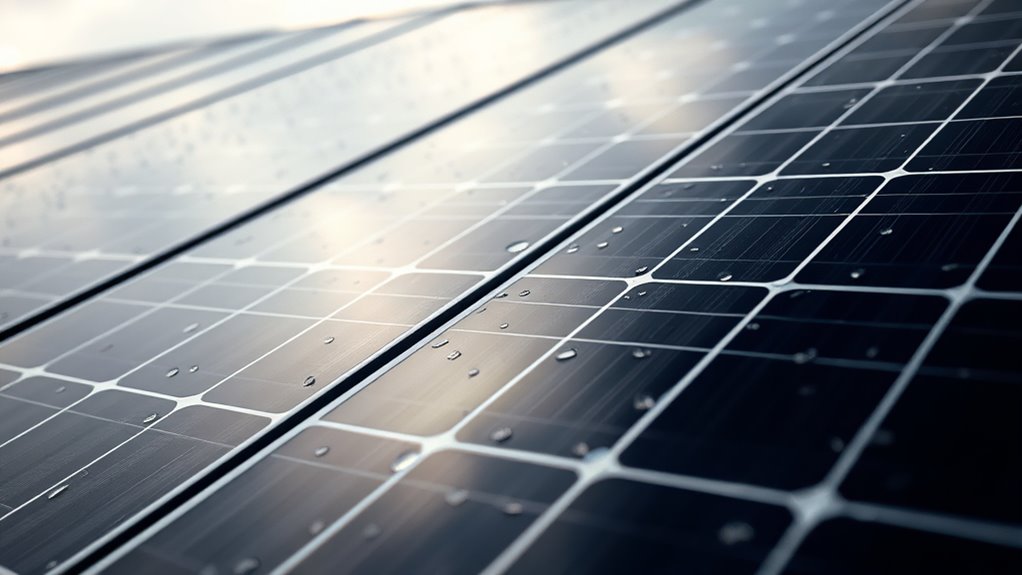
Rainy days can temporarily decrease your solar system’s efficiency, but they don’t prevent it from producing power altogether. Over time, rainwater helps keep your panels clean, which maintains their solar panel durability and ensures they operate effectively. While the immediate output may dip due to overcast skies, your system still generates electricity, just at a lower rate. Plus, rain can help remove dust and debris that block sunlight, ultimately boosting long-term performance. It’s important to recognize that short-term drops in efficiency aren’t a sign of system failure. Instead, they’re a normal part of solar energy’s ebb and flow. Proper installation ensures panels are weather-resistant and can withstand rain without damage, making rainy days less of a concern. Rain doesn’t damage your panels if they’re properly installed, and the natural cleaning from rainfall can even benefit your rainwater harvesting efforts.
Benefits of Rain for Solar Panel Maintenance and Longevity
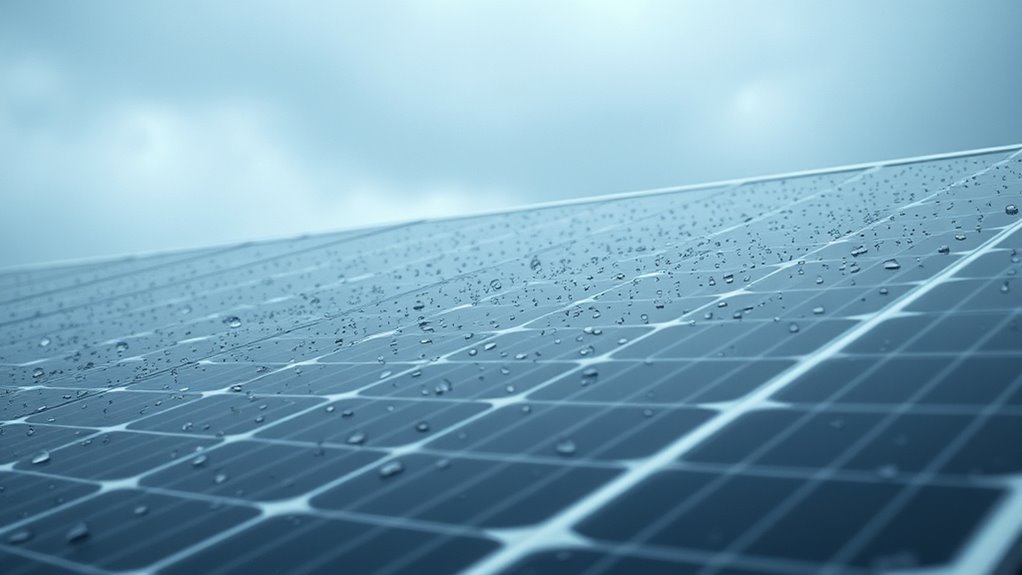
Rain naturally cleans your solar panels, removing dust, dirt, and debris that can block sunlight and reduce efficiency. This natural cleaning process can decrease the frequency of maintenance routines you need to perform, saving you time and money. Regular rain helps keep your solar panel installation in good condition, preventing buildup that could cause long-term damage or corrosion. By reducing the accumulation of grime, rain supports the longevity of your system, ensuring it continues to operate at *ideal* levels. You won’t need to rely solely on manual cleaning or additional maintenance tasks, which can be costly and labor-intensive. Instead, the rain acts as a natural, eco-friendly cleaning agent, contributing to the overall health and durability of your solar panels over time. Understanding credit card terms and how they relate to solar financing options can also help you make more informed investment decisions.
Real-World Examples of Solar Output During Gloomy Weather

Even on cloudy days, your solar panels can still produce power, though the amount varies with cloud cover. Partial sunlight can generate enough energy to keep some devices running, proving efficiency during gloomier weather. Exploring real-world examples helps you understand how weather impacts your system’s performance and what to expect on rainy days. Properly maintained panels and optimal placement can maximize energy output even in less-than-ideal weather conditions and weather resilience.
Cloud Cover Impact
Cloud cover can markedly reduce the efficiency of solar panels, even on days when the sky is overcast. When thick clouds block sunlight, your panels receive less direct sunlight, leading to decreased energy output. Weather variability means that solar performance during gloomy days fluctuates considerably, depending on cloud density and movement. You might notice a sharp drop in power during prolonged overcast periods or rain showers. However, some sunlight filters through lighter clouds, so your system still produces some energy, just at a lower rate. Real-world examples show that while solar panels can operate during cloudy weather, their efficiency is substantially affected. Understanding how cloud cover impacts your system helps you set realistic expectations and optimize your energy management during less sunny days. Additionally, solar panel performance can be significantly influenced by local weather patterns and the angle at which panels are installed.
Partial Sunlight Generation
Despite overcast conditions reducing overall solar efficiency, your panels can still generate power during periods of partial sunlight. Adjusting your solar panel tilt helps maximize exposure to diffuse sunlight, allowing more light to reach the cells even on gloomy days. Modern inverter technology plays a pivotal role by optimizing the conversion process, ensuring your system captures as much energy as possible from limited sunlight. Even when the sky isn’t clear, your panels can produce a surprising amount of electricity, especially if they’re properly angled. Real-world examples show that during cloudy mornings or late afternoons, solar output drops but remains active. This partial sunlight generation can contribute meaningfully to your overall energy needs, proving that solar power isn’t entirely dependent on bright, sunny days.
Rainy Day Efficiency
Rainy days often lead to lower solar output, but real-world examples show your panels can still produce meaningful electricity. Modern solar panel durability means they withstand harsh weather, including heavy rain and wind. Although efficiency drops during overcast skies, panels can still generate power from diffuse sunlight. Additionally, rainy conditions boost rainfall collection, helping replenish water supplies and supporting sustainable practices. Even during gloomy weather, your system’s output remains valuable, especially if you have a well-designed array. The key is understanding that solar panels don’t stop working completely on rainy days; they just operate at reduced efficiency. This resilience highlights the importance of choosing durable panels and optimizing rainwater harvesting, making your investment in solar energy both practical and environmentally friendly during all weather conditions.
Tips to Maximize Solar Power on Cloudy and Rainy Days
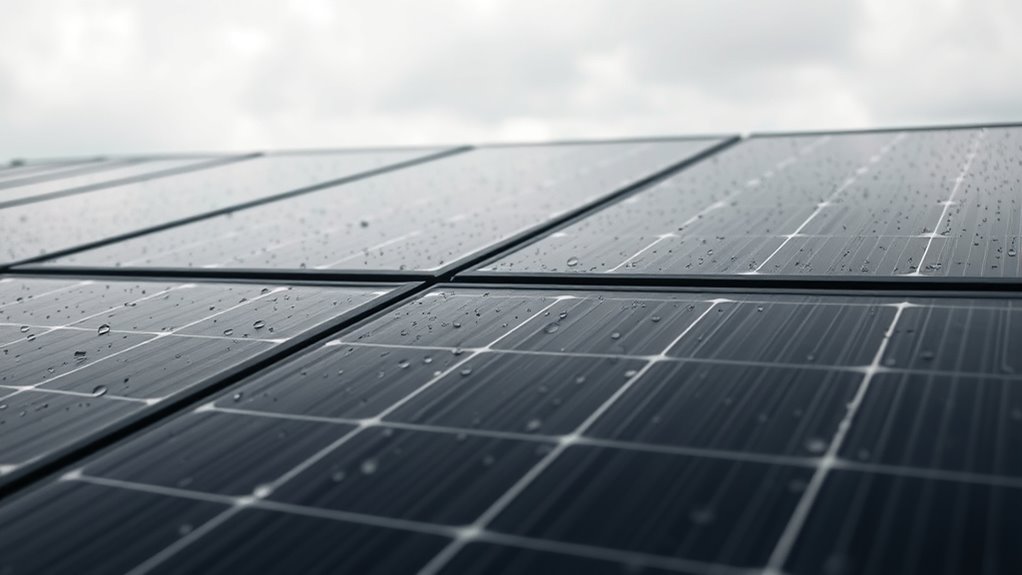
To maximize your solar panels’ efficiency on cloudy and rainy days, you need to make strategic adjustments and select the right equipment. Start by choosing high-quality solar panel materials designed for low-light conditions, such as monocrystalline panels, which perform better in diffuse sunlight. Additionally, optimize your installation techniques by positioning panels at a steeper angle to capture as much indirect light as possible. Keep panels clean and free of debris to guarantee maximum light absorption. Using micro-inverters or power optimizers can also boost energy production on less sunny days by improving overall system performance. Regularly monitor your system’s output to identify issues early. Incorporating vibe coding techniques can help automate performance tracking and system adjustments, leading to more efficient energy use. These small adjustments can considerably enhance your solar power generation during overcast and rainy weather, helping you get the most from your investment.
Why Going Solar Still Makes Sense Despite the Weather

While cloudy and rainy days can reduce your solar panels’ output, they don’t eliminate the benefits of going solar altogether. Solar panel durability ensures your system can withstand weather like rain, snow, and wind over years of use. Rainfall impact is minimal since panels are designed to handle moisture without damage, and they often clean themselves during storms, boosting efficiency. Plus, solar panels still generate electricity on overcast days, just at a lower rate, saving you money in the long run. The key is that your investment continues to pay off, regardless of weather patterns. Additionally, AI advancements are helping optimize solar energy systems for better performance in varied weather conditions.
- Solar panels are built tough to endure harsh weather
- Rain helps keep panels clean and efficient
- Even reduced output contributes to your energy savings
- Long-term durability means years of reliable power
- Going solar is a smart, resilient choice
Frequently Asked Questions
Can Rainy Weather Damage My Solar Panels?
Rainy weather doesn’t damage your solar panels because of their durability. They’re built to withstand various weather conditions, including rain, snow, and wind. Rainwater runoff actually helps clean the panels, maintaining their efficiency. You can rest assured that your solar panel durability isn’t compromised by rain. Regular maintenance and proper installation ensure they continue working well, even during rainy days, maximizing your solar energy benefits.
How Often Should I Clean My Solar Panels After Rain?
You should clean your solar panels periodically, especially if rainwater cleaning hasn’t rinsed off dirt or debris. After heavy rain, give them a quick inspection to see if dirt or leaves remain. Regular solar panel maintenance ensures peak performance, but rainwater cleaning often reduces the need for frequent washing. Typically, cleaning every six months or when you notice a drop in efficiency keeps your panels working their best.
Do Snow or Ice Affect Solar Panel Efficiency?
Snow and ice might seem harmless, but they can critically impact your solar panel efficiency. Ice accumulation can block sunlight, reducing energy production, while snow shedding is essential to keep panels clear. You should regularly clear snow and ice to maintain ideal performance. Keep in mind, panels are designed for winter conditions, but proactive maintenance ensures you maximize your solar energy even in cold, snowy weather.
Are There Specific Solar Panels Better Suited for Cloudy Weather?
You’ll find that some solar panel technology performs better in cloudy weather. Look for panels with higher efficiency ratings and those designed for low-light conditions, such as monocrystalline or bifacial panels. These are more effective when sunlight is diffused or limited. By choosing the right panels for cloudy weather, you maximize your energy production and guarantee your system works well even when skies aren’t clear.
How Does Humidity Influence Solar Energy Production?
Humidity impact is like a fog settling in, dimming your solar panel’s efficiency. High moisture effects can reduce energy output because water vapor interferes with sunlight reaching the panels. When humidity levels climb, your system might produce less power, especially during damp mornings or humid afternoons. So, to maximize your solar investment, consider how moisture effects and humidity impact your panels’ performance in your local climate.
Conclusion
Don’t let rainy days discourage you from going solar. While cloud cover and rain might dip your system’s output temporarily, they also help keep your panels clean and functioning well longer. Remember, solar panels generate energy even on overcast days—so you’re still saving money and reducing your carbon footprint. With the right system and some smart tips, you can enjoy consistent solar power year-round, rain or shine.









